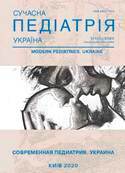Preparations with ivy extract for the treatment of cough with bronchitis in children
Keywords:
cough, children, treatment, ivy leaf extractAbstract
The physiological role of cough in the respiratory system is shown. As a pathological condition, cough occurs in many diseases. The problem of cough is particularly relevant in children. The main criterion for choosing a drug for the pathogenetic treatment of cough in children is its safety. Among medicines used to treat cough in pediatrics, herbal remedies have an advantage, they have a milder pharmacotherapeutic effect and better tolerance compared to synthetic drugs. Ivy leaf extract has long been used to treat cough. The safety and efficacy of ivy-based medicines in treating upper respiratory tract diseases, including in children, has been proven by the results of many studies.References
Antypkin JG, Chumachenko NG, Umanets TR, Lapshin VF. (2016). The aspects of respiratory organs pathological conditions dynamics among child population Sovremennaya pediatriya. 2(74): 73—77. https://doi.org/10.15574/SP.2016.74.73
Beketova HV. (2013). Kashel u detei — symptom, trebuiushchyi vnymanyia vracha. Zdorov'ia Ukrainy. Pediatriia.(26): 27.
Bolbot YuK. (2015). Mukolytycheskaia terapyia respyratornыkh zabolevanyi u detei. Zdorove rebenka 1(60): 98—102.
Korovyna NA. (2000). Kashel u detei: posobye dlia vrachei. Moscow: Posad.
Kruchko TA, Tkachenko OY, Vovk JA. (2014). Treatment of children's cough: from variety of going to inferencing Pedyatryia. Vostochnaia Evropa 3: 131—140.
Marushko YuV, Hracheva MG. (2015). Therapy in bronchopulmonary diseases associated with increased secretion of viscous sputum and impaired mucus transport. Zdorovie rebenka.1(60): 135—139. doi: 10.22141/2224-0551.1.60.2015.74978.
Marushko YuV, Moscovenko OD. (2015). Dry Сough in Сhildren: Сauses, Peculiarities of Respiratory Diseases and Treatment. Zdorovie rebenka. 1(60): 109—114. Здоров'я дитини.1(60): 109—114. https://doi.org/10.22141/2224-0551.1.60.2015.74973
Prokhorovа MP. (2015). Differentiated approach to the treatment of cough in children. Immunology and Allergology: Science and Practice.1: 112—118.
Savchenko VP. (2011). Klinichni aspekty i likuvannia kashliu u ditei. Zdorov'ia Ukrainy. Pediatriia.(18): 54—55.
Selimzyanova LR, Promyslova EA, Vishneva EA. (2013). Cough phytotherapy in children. Pediatric pharmacology. 10;4: 128—130. https://doi.org/10.15690/pf.v10i4.766
Soroka ND, Korshunova EV, Rjabyh OV, Balackaja GM i dr. (2010). Jeffektivnost' i bezopasnost' ingaljacionnogo metoda lechenija suhim jekstraktom list'ev pljushha ostryh respiratornyh zabolevanij u detej rannego vozrasta. Lechashhij vrach. 6: 14—17.
Tumanov VA, Pokanevich VV, Garnik TP, Frolov VM, Peresadin NA. (2012). Phytotherapy: application modern lines in medical practice and perspectives of the further development. Phitoterapiya. 1: 4—11.
Chernikov VV. (2012). Application of vegetable drugs for treating cough in children. Pediatric pharmacology. 9;6: 105—109. https://doi.org/10.15690/pf.v9i6.527
Anti-inflammatory effects of ivy leaves dry extract: influence on transcriptional activity of NFκB (2018). Inflammopharmacology. 27(2). https://doi.org/10.1007/s10787-018-0494-9; PMid:29748881 PMCid:PMC6482290
Dicpinigatis PV, Colice GL, Goolsby MJ et al. (2009). Acute cough: a diagnostic and therapeutic challenge. Cough. 5: 11. https://doi.org/10.1186/1745-9974-5-11; PMid:20015366 PMCid:PMC2802352
Ernst E. (2007). Herbal medicines: balancing benefits and risks. Novartis Found Symp.282: 154—67; discussion 167—72, 212—8. https://doi.org/10.1002/9780470319444.ch11; PMid:17913230
Fazio S, Pouso J, Dolinsky D, Fernandez A et al. (2009). Tolerance, safety and efficacy of Hedera helix extract in inflammatory bronchial diseases under clinical practice conditions: a prospective, open, multicentre postmarketing study in 9657 patients. Phytomedicine.16(1): 17—24. https://doi.org/10.1016/j.phymed.2006.05.003; PMid:16860549
Felix Holzinger and Jean-Franc,Ois Chenot. (2010). Systematic Review of Clinical Trials assessing the effectiveness of Ivy Leaf (Hedera Helix) for acute upper respiratory tract infections / Evidence-Based Complementary and Alternative Medicine. Vol. 2011. Article ID 382789: 9. https://doi.org/10.1155/2011/382789; PMid:20976077 PMCid:PMC2957147
Francesco De Blasio, Johann C Virchow, Mario Polverino et al. (2011). Cough management: a practical approach. Cough. 7:7. http://www.coughjournal.com/content/7/1/7. https://doi.org/10.1186/1745-9974-7-7; PMid:21985340 PMCid:PMC3205006
Greunke C, Hage-Hulsmann A, Sorkalla T, Keksel N et al. (2015). A systematic study on the influence of the main ingredients of an ivy leaves dry extract on the b2-adrenergic responsiveness of human airway smooth muscle cells. Pulm Pharmacol Ther.31: 92—98. https://doi.org/10.1016/j.pupt.2014.09.002; PMid:25234924
Hocaoglu AB, Karaman O, Erge DO et al. (2012) Effect of Hedera helix on lung histopathology in chronic asthma. Iran J Allergy Asthma Immunol. 11: 316—323.
Hofmann D, Hecker M, Volp A. (2003, Mar). Efficacy of dry extract of ivy leaves in children with bronchial asthma — a review of randomized controlled trials. Phytomedicine.10(2—3): 213—20. https://doi.org/10.1078/094471103321659979; PMid:12725580.
Irwin RS, Baumann MH, Bolser DC et al. (2006, Jan). Diagnosis and management of cough: ACCP evidence-based clinical practice guidelines. Chest. 129 (1): 1S-23S. https://doi.org/10.1378/chest.129.1_suppl.24S
Janka Schulte-Michels, Anne Wolf, Stefan Aatz et al. (2016). α-Hederin inhibits G-protein-coupled receptor kinase 2-mediated phosphorylation of β2-adrenergic receptors. Phytomedicine. 23: 52—57. https://doi.org/10.1016/j.phymed.2015.12.001; PMid:26902407
Marquardt P, Kaft K, Nieber K. (2015). Clinical trials with herbal medicinal products in children: a literature analysis. Wien Med Wochenschr.165 (11—12): 236—242. https://doi.org/10.1007/s10354-015-0373-6; PMid:26183729
Schmidt M, Thomsen M, Schmidt U. (2012). Suitability of ivy extract for the treatment of paediatric cough. Phytother Res.26(12): 1942—1947. https://doi.org/10.1002/ptr.4671; PMid:22532491
Sieben A, Prenner L, Sorkalla T, Wolf A et al. (2009). α-Hederin, but not hederacoside C and hederagenin from Hedera helix, affects the binding behaviour, dynamics and regulation of beta 2-adrenergic receptors. Biochemistry.48: 3477—3482. https://doi.org/10.1021/bi802036b; PMid:19278262
Suleyman H, Mshvildadze V, Gepdiremen A, Elias R. (2003). Acute and chronic antiinflammatory profile of the ivy plant, Hedera helix, in rats. Phytomedicine. 10: 370—374. https://doi.org/10.1078/0944-7113-00260; PMid:12834000
World Health Organization. (2010). WHO monographs on medicinal plants commonly used in the Newly Independent States (NIS). Geneva: WHO-Press: 464.
Downloads
Issue
Section
License
The policy of the Journal “MODERN PEDIATRICS. UKRAINE” is compatible with the vast majority of funders' of open access and self-archiving policies. The journal provides immediate open access route being convinced that everyone – not only scientists - can benefit from research results, and publishes articles exclusively under open access distribution, with a Creative Commons Attribution-Noncommercial 4.0 international license (СС BY-NC).
Authors transfer the copyright to the Journal “MODERN PEDIATRICS. UKRAINE” when the manuscript is accepted for publication. Authors declare that this manuscript has not been published nor is under simultaneous consideration for publication elsewhere. After publication, the articles become freely available on-line to the public.
Readers have the right to use, distribute, and reproduce articles in any medium, provided the articles and the journal are properly cited.
The use of published materials for commercial purposes is strongly prohibited.

